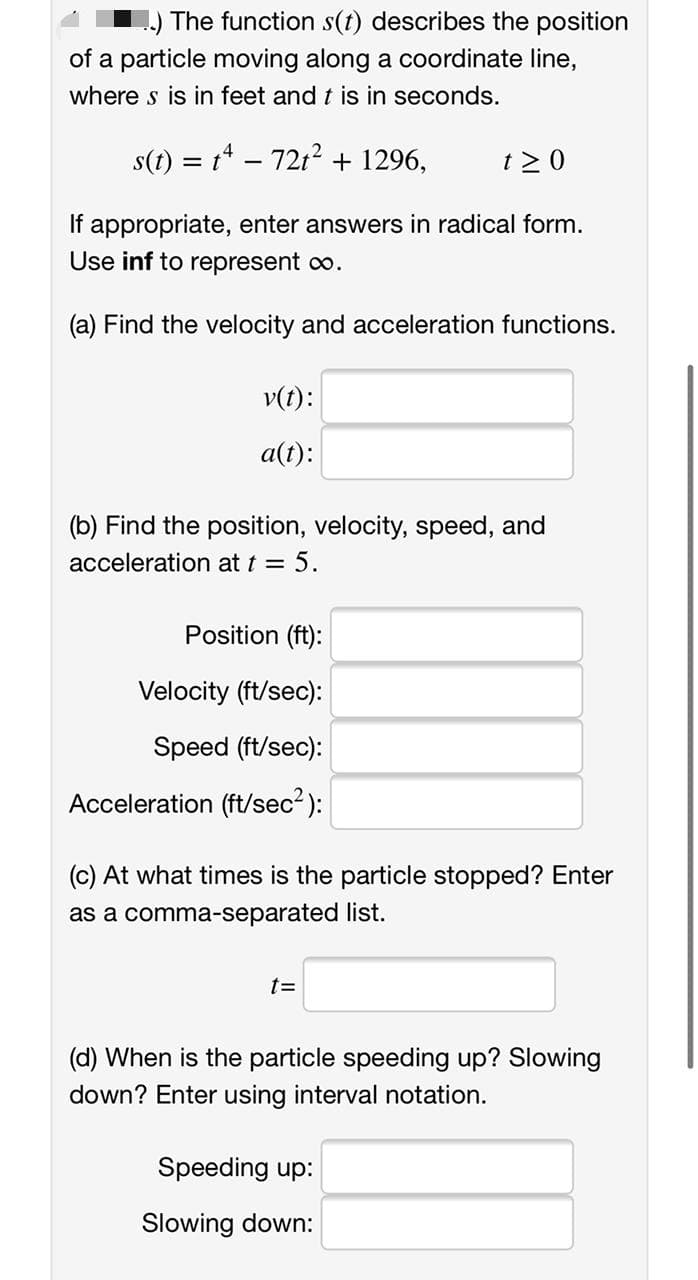1.) The function s(t) describes the position of a particle moving along a coordinate line, where s is in feet and t is in seconds. s(t) = t4 – 721? + 1296, t 2 0 If appropriate, enter answers in radical form. Use inf to represent o. (a) Find the velocity and acceleration functions. v(t): a(t): (b) Find the position, velocity, speed, and acceleration at t = 5. Position (ft): Velocity (ft/sec): Speed (ft/sec): Acceleration (ft/sec? ): (c) At what times is the particle stopped? Enter as a comma-separated list. t= (d) When is the particle speeding up? Slowing down? Enter using interval notation.
1.) The function s(t) describes the position of a particle moving along a coordinate line, where s is in feet and t is in seconds. s(t) = t4 – 721? + 1296, t 2 0 If appropriate, enter answers in radical form. Use inf to represent o. (a) Find the velocity and acceleration functions. v(t): a(t): (b) Find the position, velocity, speed, and acceleration at t = 5. Position (ft): Velocity (ft/sec): Speed (ft/sec): Acceleration (ft/sec? ): (c) At what times is the particle stopped? Enter as a comma-separated list. t= (d) When is the particle speeding up? Slowing down? Enter using interval notation.
Physics for Scientists and Engineers, Technology Update (No access codes included)
9th Edition
ISBN:9781305116399
Author:Raymond A. Serway, John W. Jewett
Publisher:Raymond A. Serway, John W. Jewett
Chapter3: Vectors
Section: Chapter Questions
Problem 3.62AP: After a ball rolls off the edge of a horizontal table at time t = 0, its velocity as a function of...
Related questions
Question

Transcribed Image Text:) The function s(t) describes the position
of a particle moving along a coordinate line,
where s is in feet and t is in seconds.
s(t) = t* – 7212 + 1296,
t > 0
If appropriate, enter answers in radical form.
Use inf to represent o.
(a) Find the velocity and acceleration functions.
v(t):
a(t):
(b) Find the position, velocity, speed, and
acceleration at t = 5.
Position (ft):
Velocity (ft/sec):
Speed (ft/sec):
Acceleration (ft/sec2 ):
(c) At what times is the particle stopped? Enter
as a comma-separated list.
t3D
(d) When is the particle speeding up? Slowing
down? Enter using interval notation.
Speeding up:
Slowing down:
Expert Solution
This question has been solved!
Explore an expertly crafted, step-by-step solution for a thorough understanding of key concepts.
This is a popular solution!
Trending now
This is a popular solution!
Step by step
Solved in 5 steps

Knowledge Booster
Learn more about
Need a deep-dive on the concept behind this application? Look no further. Learn more about this topic, physics and related others by exploring similar questions and additional content below.Recommended textbooks for you

Physics for Scientists and Engineers, Technology …
Physics
ISBN:
9781305116399
Author:
Raymond A. Serway, John W. Jewett
Publisher:
Cengage Learning

Physics for Scientists and Engineers, Technology …
Physics
ISBN:
9781305116399
Author:
Raymond A. Serway, John W. Jewett
Publisher:
Cengage Learning